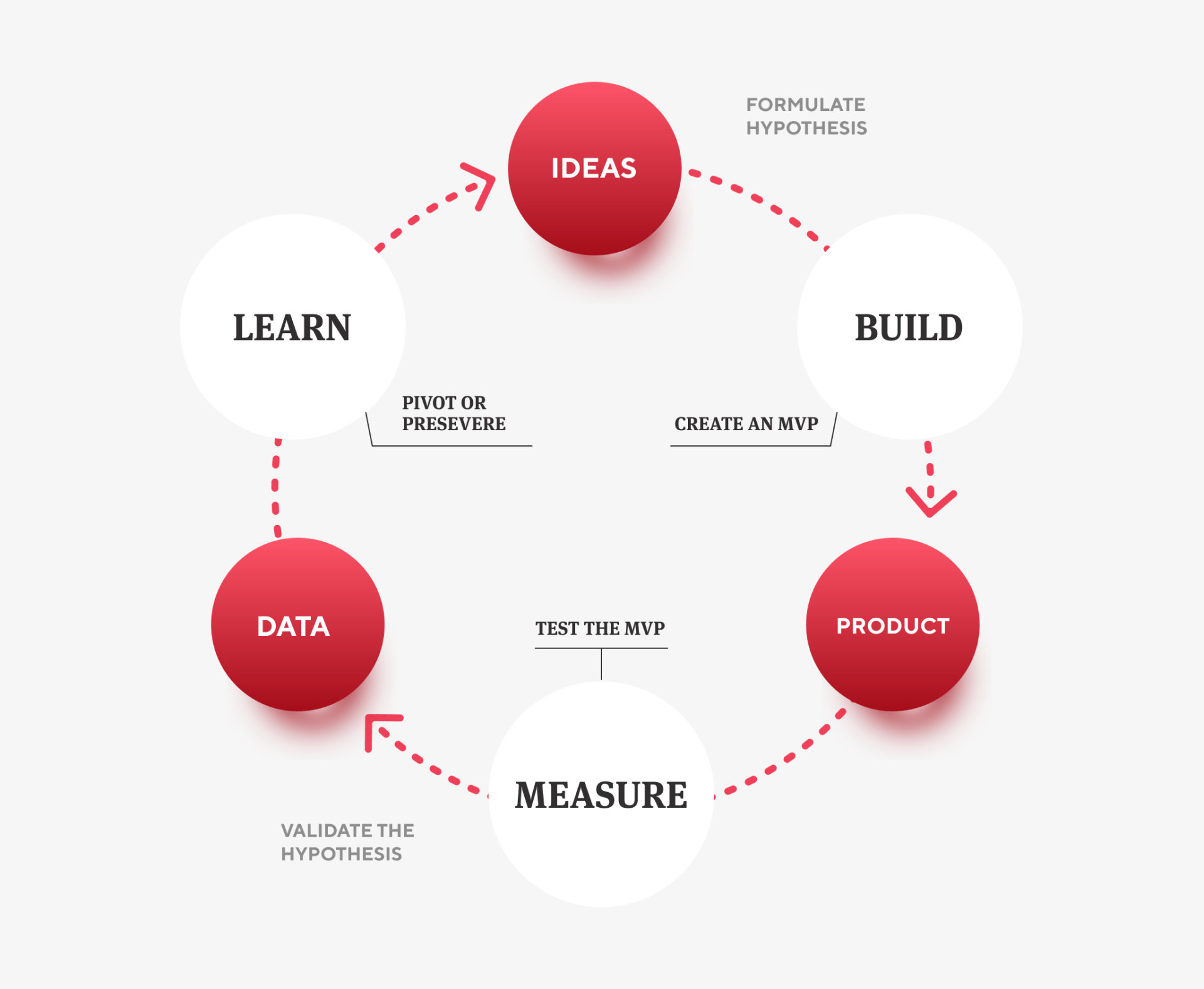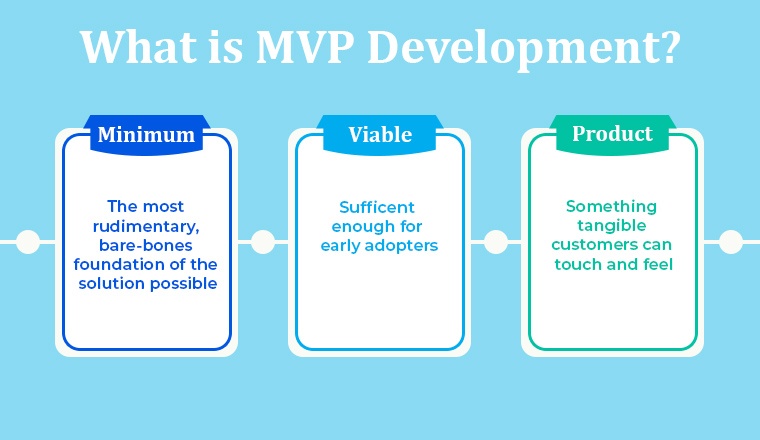9 min to read
Product Development Cycle Fundamentals: What you need to know.

Product Development Cycle
The product development cycle aims to conceptualize how an idea turns into a product that could solve the pain point in a manner that maximizes its chances of getting traction and reduce the risk of it being obsolete or non-value adding.
CodeDesign is the leading digital marketing agency in Lisbon Portugal.
Ideation stage and its importance in the product development

Idea stage in product development
The ideation stage is a critical phase in the product development stage because you would be judging many ideas, identifying problems, trying to see things from a different perspective, and adding a mix of creativity to ensure you are working in the right direction.
It is often expected that most entrepreneurs in this stage end up having a lot of 'features' or 'ideas' in mind that sometimes it becomes confusing what to approach first. Ideas beget ideas, but the primary step is understanding the most viable solution or product your customers would love to see.
One practical approach to uncovering opportunities is the SCAMPER method. This technique encourages thinking outside the box by innovatively reimagining existing products and services. The acronym prompts entrepreneurs to Substitute, Combine, Adapt, Modify, Put to other use, Eliminate, or Reverse each element of a given product.
For instance, one can adapt existing solutions, apply them to different markets, or combine features from various effects to create something new. Read this complete guide on digital marketing funnel and then choose the right digital marketing channel for your business.
Validation Phase

The validation stage is crucial because you need to be sure there is a market for the problem you are trying to solve. Many founders start by trying to do focused interviews with their ideal target customers to get a few ideas about their better version of solving a problem. But, it generally tends to have a few objections, like what if the prospect needs to know what he wants or is hesitant to give constructive criticism about the ideas. But, it is essential to navigate through these challenges and ultimately talk to the customers. You could ask open-ended questions about the problem and see how they solve it at present or get to know their priority.
Many people suggest you build landing pages with the correct copy to see how many pre-subscriptions you get for your idea as part of the market validation. Check these Amazon FBA tips to grow your business and see how optimising your Amazon listing could help you grow.
Building a Prototype

prototype building
Once you have finalized your product idea, the next step is to create a prototype. This is a crucial stage in product development because it allows you to bring your vision to life and test its feasibility. To begin, you need to determine the key features and functions that should be included in your product. These features will serve as the foundation of your product when it is launched, and they should be based on the feedback and insights you gathered during the validation process.
After identifying the key features, you can start building a mockup or a working model of your product using wireframing tools such as Figma or Sketch. It allows you to visually represent your product idea, gather feedback from potential customers, and assess its usability. This iterative process helps you refine your product concept and ensures you're on the right track before investing further resources into the development process.
Read this guide on E-commerce supply chain and voice search optimization.
How should you approach MVP development?

MVP development
When working on a minimum viable product, the first step is to understand your target audience's needs and pain points and have a clear idea of what you could deliver to increase the value customers receive. Now obviously, it doesn't mean that your first version of the product would be successful or even close to 'amazing,' but the purpose that it means to serve is to get direct customer feedback, which then allows you to make iterations.
To identify these needs, the initial step involves pinpointing the gap between how customers currently address their problems or the products they now possess and a potential solution. By thoroughly analyzing this gap, we gain valuable insights into what is missing, what can be improved, and how we can offer a solution that exceeds their expectations.
The next step that now comes is gathering data from our customers. There is a common belief in Silicon Valley that addressing a problem you personally face brings a higher level of commitment and dedication. In such cases, you already have a clear understanding and a starting point to articulate and document the specific needs of your target customers. Moreover, by being intimately familiar with the problem ourselves, we bring a deep sense of empathy to the table. This empathy enables us to connect with our customers genuinely, as we share their experiences and can relate to their challenges. It creates a strong foundation for building a solution that truly resonates with their needs and delivers tangible value.
By starting with an MVP, you can gather valuable feedback and data from early users, allowing you to validate assumptions, identify areas for improvement, and make informed decisions about the product's future direction. This iterative approach enables you to refine and enhance the development based on real-world usage and user feedback.
The key is to strike a balance between releasing a product that meets the minimum requirements and ensuring it delivers value to your target audience.
As you gather insights and learn from users, you can prioritize and add new features based on their needs and preferences. This incremental development approach reduces the time and resources required upfront and enables you to adapt and pivot based on market feedback.
Getting the MVP in front of the early adopters

Early adopters often come as saviours
When you have your MVP ready, getting it in front of potential adopters and tracking data on how they use it is essential. Once you can identify the unique value proposition and how your solution is better than what is already in the market, when you get early adopters, you must establish a mechanism for ongoing communication with them. This can be through email newsletters, dedicated feedback channels, or online surveys. Regularly update them on product developments and involve them in shaping the future of your product.
Talking to customers with a product > Talking to potential customers with an idea.

In the words of Michael Siebel, the Managing Director of Y Combinator, the founders should launch an MVP as soon as possible rather than spending excessive time on surveys, interviews, and other distractions. By putting a product in front of users, founders can learn whether it helps them. The goal is to understand user needs and iterate the product to provide value.
The idea behind this method of validating ideas is that through repeated cycles of talking to users and iterating the product, founders can make significant improvements and learn from their users' feedback. Also, in this stage, it becomes equally essential for founders not to get caught up in overanalyzing or perfection; instead, they should talk to early adopters to start the conversation with users.
A sentence could summarize it as "Startups begin without all the answers, and the early phase is focused on learning and adapting based on user feedback."
FAQS - Frequently Asked Questions
What is the significance of the ideation stage in product development?
The ideation stage in product development is crucial as it lays the foundation for all subsequent stages of bringing a new product to market. This phase involves brainstorming and generating a wide range of ideas, without judgment, that address specific customer needs or market gaps. The significance of ideation lies in its potential to unleash creativity and innovation, enabling teams to explore diverse solutions and approaches. It's a period of exploration and freedom that encourages thinking outside the box, which is essential for developing unique and competitive products. Effective ideation can lead to the discovery of breakthrough concepts that form the cornerstone of successful products.
How does the SCAMPER method facilitate creative ideation?
The SCAMPER method facilitates creative ideation by providing a structured approach to thinking differently about a product or service. It stands for Substitute, Combine, Adapt, Modify, Put to another use, Eliminate, and Reverse. Each of these prompts encourages individuals to explore various aspects of an idea or existing product to generate innovative solutions. By systematically questioning and altering aspects of an idea, SCAMPER helps overcome creative blocks, leading to the discovery of novel improvements or entirely new products. This method ensures a comprehensive exploration of possibilities, making ideation more productive and diverse.
What challenges might arise during the validation phase, and how can they be navigated?
During the validation phase, startups may encounter challenges such as receiving ambiguous feedback, identifying the right target audience, and dealing with limited resources for extensive market research. To navigate these challenges, it's important to clearly define validation criteria and use a combination of quantitative and qualitative research methods to gather actionable insights. Directly engaging with potential customers through interviews, surveys, and prototype testing can provide valuable feedback. Prioritizing and addressing critical feedback while being flexible and open to pivoting the product concept as needed can help overcome obstacles in validating a product's market fit.
How does building a prototype contribute to the product development process?
Building a prototype is a pivotal step in the product development process as it brings the conceptual idea into a tangible form. This allows the development team and stakeholders to examine the product's feasibility, functionality, and design firsthand. Prototypes facilitate early testing, enabling the identification and rectification of issues before full-scale production. They also provide a vital tool for engaging with potential customers, gathering feedback, and validating the product concept. Through iterative prototyping, teams can refine and improve their product, ensuring that it better meets user needs and expectations, ultimately contributing to a more successful final product.
What strategies can be employed in MVP development to ensure it meets customer needs?
In MVP (Minimum Viable Product) development, employing strategies such as focusing on core functionalities that solve the primary problem, engaging with potential users early in the process, and incorporating feedback loops are essential to ensure it meets customer needs. Starting with a clear understanding of the target market and their pain points helps in defining the MVP's essential features. Continuous user testing and feedback collection post-launch provide insights into user experiences and preferences, guiding further development. Agile development practices allow for quick iterations based on this feedback, ensuring the MVP evolves in alignment with customer expectations and needs.
How can early adopters influence the iterative development of a product?
Early adopters play a critical role in the iterative development of a product by providing initial feedback, suggestions, and insights based on their experiences. Their engagement can validate assumptions made during the ideation and development phases, uncover unforeseen issues, and identify opportunities for improvement or innovation. By actively incorporating feedback from early adopters, companies can make informed adjustments to their products, enhancing usability, functionality, and market fit. Early adopters also help in building momentum and credibility for the product through word-of-mouth promotion, contributing to its success in broader markets.
Why is talking to customers with a product more beneficial than just an idea?
Talking to customers with a product, rather than just an idea, is more beneficial because it provides concrete evidence of how the product works and its potential value. Customers can interact with the product, providing direct and specific feedback on its features, usability, and effectiveness in solving their problems. This hands-on experience generates more accurate and actionable insights than abstract discussions about a concept, helping refine the product to better meet customer needs. Additionally, presenting a tangible product demonstrates commitment and progress, potentially increasing customers' interest and investment in the product's success.
How can feedback from early adopters be effectively gathered and utilized?
Feedback from early adopters can be effectively gathered through structured surveys, in-depth interviews, usability testing, and monitoring of user behavior analytics. Establishing open communication channels where early adopters can share their experiences and thoughts is also crucial. To utilize this feedback effectively, it's important to analyze the data to identify patterns, prioritize the feedback based on its impact on the user experience and the product's goals, and then iteratively implement changes. Engaging with early adopters throughout this process, validating the adjustments made, and continuously seeking their input can ensure the product evolves in alignment with user needs and preferences.
What role does empathy play in identifying and solving customer problems during product development?
Empathy plays a fundamental role in product development by enabling creators to deeply understand and connect with the users' experiences, challenges, and needs. By adopting an empathetic approach, teams can identify with the customer's perspective, leading to a more accurate and nuanced understanding of the problems they face. This insight drives the development of solutions that truly resonate with users, addressing their needs in a meaningful and effective way. Empathy fosters a user-centered design process, ensuring that products are not just functional but also genuinely enhance users' lives by solving real problems in intuitive and accessible ways.
How can a balance between minimum requirements and value delivery be achieved in MVP development?
Achieving a balance between minimum requirements and value delivery in MVP development involves identifying the core feature or features that solve the primary problem for your target audience while requiring the least amount of time and resources to develop. This entails thorough market research, customer interviews, and competitive analysis to pinpoint the essential value proposition of the product. Prioritization frameworks can be used to distinguish must-have features from nice-to-haves. Iterative testing and feedback loops with potential users are crucial to refine the MVP, ensuring it meets customer needs effectively without overextending resources on unnecessary features. This lean approach maximizes value delivery by focusing on simplicity, usability, and solving core user problems efficiently.

About Bruno GavinoBruno Gavino is the CEO and partner of Codedesign, a digital marketing agency with a strong international presence. Based in Lisbon, Portugal, with offices in Boston, Singapore, and Manchester (UK) Codedesign has been recognized as one of the top interactive agencies and eCommerce agencies. Awarded Top B2B Company in Europe and Top B2C company in retail, Codedesign aims to foster personal relationships with clients and create a positive work environment for its team. He emphasizes the need for digital agencies to focus on data optimization and performance to meet the increasingly results-driven demands of clients. His experience in digital marketing, combined with a unique background that includes engineering and data, contributes to his effective and multifaceted leadership style. |

About CodedesignCodedesign is a digital marketing agency with a strong multicultural and international presence, offering expert services in digital marketing. Our digital agency in Lisbon, Boston, and Manchester enables us to provide market-ready strategies that suit a wide range of clients across the globe (both B2B and B2C). We specialize in creating impactful online experiences, focusing on making your digital presence strong and efficient. Our approach is straightforward and effective, ensuring that every client receives a personalized service that truly meets their needs. Our digital agency is committed to using the latest data and technology to help your business stand out. Whether you're looking to increase your online visibility, connect better with your audience, get more leads, or grow your online sales. For more information, read our Digital Strategy Blog or to start your journey with us, please feel free to contact us. |
CodeDesign is leading:
- Digital Agency
- Digital Marketing Agency
- Digital Ecommerce Agency
- Amazon Marketing Agency

Add comment ×